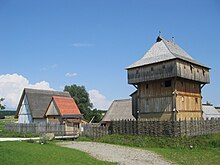Bach knights castle Kanzach
Coordinates: 48 ° 4 ′ 48.4 " N , 9 ° 33 ′ 31.3" E
The Bachritterburg Kanzach is an open-air museum on the outskirts of Kanzach in the Biberach district in Baden-Württemberg and is located about five kilometers west of the Federsee . The castle is a replica of a medieval wooden tower hill castle (motte) of the lower nobility based on scientific principles . Since there were no excavation findings for the castle of the Kanzach brook knights, the Eschelbronn moated castle served as a model for the reconstruction.
Structure and location
Historically Bachritterburg is the nickname for the Built around 1230, the castle of Bach Knights back bearing Kanz Acher local nobility on the Schlößlesberg at Kanzach. It was built in the style of a medieval hilltop castle by the nobleman Ortolf von Pflummer. In the absence of excavation findings from Kanzach, reconstruction was carried out on the Eschelbronn moated castle , which was excavated in the 1970s, but the excavation findings were not published until 1996. Eschelbronn Castle, located in northern Baden, whose oak beams were built according to dendrochronological findings in 1271, is of the same type as facilities in northern Switzerland, so that it is assumed that this type of construction will spread throughout southwest Germany around 1300. For the construction details in the roof structure, for which there were no excavation findings from Eschelbronn, the orientation was at the Templar House in Amorbach in the Odenwald, which, according to dendrochronological findings, was built only about 20 years after the moated castle in Eschelbronn and, like this, probably also by the Lords of Dürn .
The completely reconstructed castle shows a residential tower on a low moth in the core castle , followed by the farm buildings of the outer castle .
The Bachritterburg in Kanzach belongs to the ArchäoPark Federsee , together with the renowned Federseemuseum . As a result of the merger, the time window spans from the Paleolithic to the late Middle Ages . History buffs are offered both original finds as well as reconstructions and replicas. From April to October noble ladies, knights , merchants and servants demonstrate everyday life in the Middle Ages with cooking and dining, handicrafts such as dyeing, spinning, weaving and embroidery, but also forging and various types of combat and weapons. Living history and experimental archeology offer the visitor a tangible picture of the past.
Emergence
The suggestion for building the Bachritterburg came from the archaeologist Karl Banghard , who, after initial hesitation, found the support of the then mayor Rudolf Obert and the local council. Of the roughly two million euros in construction costs, 70 percent was financed by the EU through the LEADER program, with the state of Baden-Württemberg and the municipality of Kanzach each bearing 15 percent of the costs. In addition to the Regensburg architect Gottfried Schulze, the Regensburg archaeologist Tilman Mittelstraß, who had evaluated and published the excavation results from Eschelbronn, was also involved in the planning. The construction took place in two phases: in 2001 the wooden residential tower was built, the outer bailey was built in 2004.
business
In 2005 the rumor arose that the municipality of Kanzach was close to insolvency, and that the costs for the Bachritterburg had placed an excessive burden on the municipal budget. At the time, the news magazine Der Spiegel described Kanzach as an example of how municipalities "slide into the lousy" with "pointlessly given funding". The then mayor Obert commented: “It was a dark hour for Kanzach. Nothing that Der Spiegel wrote was right. ”Although the Bach knights' castle has remained a subsidy business for the municipality of Kanzach to this day (2011), according to the mayor of Kanzach, Erwin Hölz, no more than 10,000 euros a year had to be added from the municipal treasury. Many volunteers from the village help with the operation and necessary repairs, the management and maintenance of the castle is also supported by a "Friends of the Bachritterburg". Every year around 25,000 people visit the Bachritterburg, which leads to around 2500 overnight stays by guests in the village. This makes building the knight's castle as an attraction even lucrative.
According to a report in the online newspaper BLIX on July 28, 2020, the municipality of Kanzach intends to realign the operating concept, in which the living history groups that have previously been largely free of charge are no longer to be taken into account. Instead of the nationally known castle revitalization, with which excerpts of everyday life in a medieval settlement in different epochs were vividly conveyed to interested visitors, the future focus will be on cabaret, gastronomy and museum education.
Trivia
The then MEP Elisabeth Jeggle described the Bachritterburg as a “successful example of promoting structurally weak areas”.
Individual evidence
- ↑ Mittelstraß 2002, p. 43.
- ↑ a b c Uwe Jauß: A village maintains its newly built knight's castle. In: Schwäbische Zeitung , January 3, 2009
- ↑ Bach knights are looking for new ways. July 28, 2020
literature
- Tilman Mittelstraß: The reconstruction of a wooden tower castle from the Middle Ages from Kraichgau . In: Kraichgau. Contributions to landscape and local research . Episode 17, 2002, pp. 43-50.


